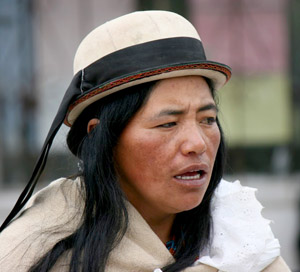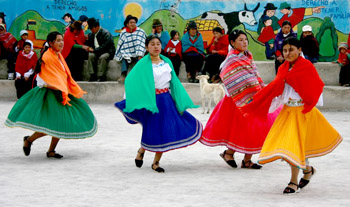 |
(Dec. 14, 2012 - by Ralph Kurtenbach) The coppery faces captured by Irene Schirmacher's camera lens reflect the struggles of living in Capulispungo. As she observed following an afternoon there, "You can see their lives in their faces."
Some 164 families were represented as people gathered on Friday, Oct. 12, to inaugurate the new clean water system. At the occasion marked by music, preaching, dancing and food, an elderly Quichua couple displayed in a palpable way their long struggle for community's clean water. On their backs were a ceramic jug and an old rusted tank previously used to carry pure spring water for their families.
Perhaps the water system's biggest beneficiaries are the little ones. The risk to children is great when diarrhea sets in after contracting waterborne diseases. Dehydration can quickly take a child's life. Shy, smiling children trailed Irene and Hermann Schirmacher's daughter, Tamara, throughout the morning before working up the courage to talk and eventually be photographed with her.
 |
| Clay pots to carry water long distances will no longer be needed in Capulispungo as demonstrated at the ribbon-cutting ceremony to dedicate a new water system on Oct. 12. |
Community development staff members provided the technical help needed, coordinated purchases and raised the majority of the funds required. Residents in Capulispungo, a community high in Ecuador's Andean region, built the reservoirs and hand dug the required 11 miles of four-foot-deep trench.
Two HCJB Global work teams participated in the manual work, including a team formed by the mission's employees. Spiritual formation is an important part of the work and is integrated with the health and hygiene teaching led by Tannia Lascano and Ecuadorian staff members from the community development team.
Mennonite churches in Germany contributed pipe and materials and were represented at the ceremony by the Schirmachers' friends, Ernst and Kathy Unrau of the Ostwestfalen-Lippe region. Hermann joined other dignitaries on the speakers' dais in a ceremony that featured primarily Spanish and Quichua, but also some German.
 |
| Local residents celebrate the new water system with a lively, colorful dance. |
After the crowd enjoyed a sumptuous meal, the piñatas spilled out treats for the children. The festivity began winding down-too quickly for Irene, hoping for a breakthrough into the lives the community's mothers and children. She was thankful, however, for the invitation into a Quichua woman's home.
The modest home was adequate and-as with all Capulispungo homes now-boasted a water spigot offering cold mountain spring water 24 hours a day.
Source: HCJB Global
